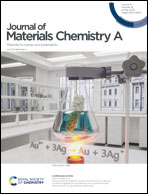Mechanisms of carbon dioxide reduction on strontium titanate perovskites
Abstract
Strontium titanate (SrTiO3) is a promising material for the light-driven conversion of carbon dioxide (CO2) into renewable fuels. However, the mechanisms of the relevant reactions are not yet well understood. In this work, we have used density functional theory calculations to explore CO2 reduction on the (001) surface of the SrTiO3 photocatalyst. Our results indicate that, in contrast to COOH, the formation of a HCOO or CO2− intermediate is thermodynamically hindered, which is consistent with the fact that formic acid (HCOOH) is not a major product in the experiments reported in the literature. We show that a pathway to carbon monoxide (CO) is instead possible, and that the formation of COOH is the rate-limiting step. Finally, we suggest that substitutional doping of Sr ions represents a promising approach to lower the energy barrier of the COOH formation.



 Please wait while we load your content...
Please wait while we load your content...